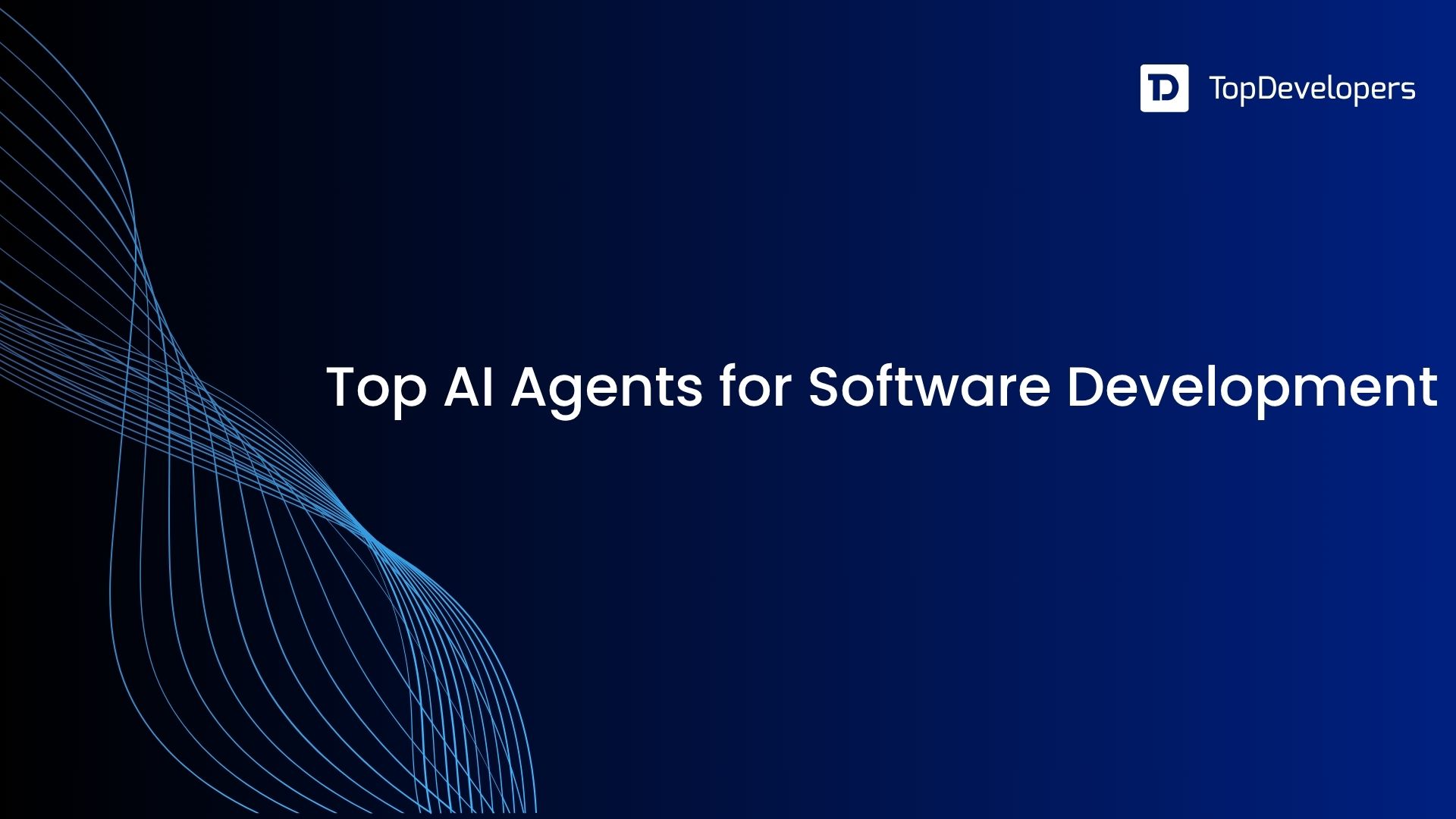
Building modern applications is now faster, smarter, and more accessible than ever—thanks to AI-powered tools like Lovable.dev. Designed with automation and simplicity in mind, Lovable turns plain ideas into functional apps using natural language prompts and intuitive workflows. Its unique “vibe coding” approach—where you guide development by describing what you want and removes the need for traditional coding entirely. This makes it a favorite among non-technical founders, solo entrepreneurs, and creative thinkers who want to build apps without the learning curve of code.
But as the landscape evolves, so do user expectations. In 2025, many creators and developers are starting to hit the limits of what Lovable can offer. While it’s great for getting started, users often want more flexibility, deeper backend control, or broader design options. Some need better collaboration tools. Others are looking for advanced features like database integrations, scalable hosting, or direct access to source code.
That’s where alternatives come into play.
Whether you’re a startup founder building your MVP or a product team launching something more complex, there are now a variety of tools that meet different needs. Some platforms are built for speed. Others focus on deep customization or team collaboration. What matters most is choosing the tool that fits your goals and technical comfort level.
This guide explores the top Lovable alternatives in 2025. We’ve reviewed each option based on real-world use cases—not just feature lists. The goal is to help you find a platform that works for you, whether you’re a complete beginner or a seasoned developer.
Each tool listed here brings something unique to the table. Let’s dive into the best picks and see which platform matches your vision and workflow best.
Table of Contents
How We Evaluated the Best Lovable Alternatives
To help you make a smart and confident choice, we’ve broken down our selection criteria into practical, real-world categories. Each platform was reviewed through the lens of usability, functionality, and long-term value.
AI Capabilities
One of the most important factors we considered is how “smart” the AI behind the platform really is. It’s not enough for a tool to generate code—it needs to generate clean, efficient, and usable code. We looked at how well these platforms understand prompts, handle complex workflows, and support logical functions without constant user correction.
We also examined how helpful the assistant features were in guiding users through the app-building process. Platforms that offer strong AI suggestions, fix errors proactively, or adapt to user behavior scored higher. In short, we wanted AI that feels like a reliable teammate—not just a fancy interface.
Ease of Use & Learning Curve
A great platform should feel welcoming—especially to non-developers. That’s why we focused heavily on ease of use. We tested how intuitive each interface was, how clearly features were explained, and how quickly a new user could start building something real.
We also paid attention to tutorials, onboarding processes, and learning resources. Tools that offer a smooth start and don’t overwhelm beginners performed better. Whether you’re tech-savvy or a total newbie, ease of use can make or break your experience. The best tools strike a balance between simplicity and power without unnecessary friction.
Customization & Code Control
Not all builders need full access to the backend—but many do. For those who want to go beyond presets and templates, customization is critical. We evaluated how much control each platform gives over the generated code, UI components, logic, and backend services.
We also looked at how easily users can plug in APIs, modify workflows, or expand their applications. Platforms that support editing code, building from scratch, or integrating third-party services ranked higher here. Flexibility is key for creators who want something truly tailored—not just prepackaged.
Feature Set
Features define what a tool can help you build. We analyzed both frontend and backend offerings to ensure each platform can handle real application demands. This included support for responsive design, component libraries, form builders, and drag-and-drop tools.
On the backend side, we checked for built-in database support, authentication, analytics, and cloud deployment options. The strongest platforms provided an all-in-one experience with minimal need for outside tools. If a builder offered full-stack functionality out of the box, it earned extra points in our review.
Pricing Structure
Price matters—especially for startups and solo builders. We looked at how each platform structures its pricing: whether it’s transparent, scalable, and fair. Free tiers were a plus, but we also considered the value of paid plans and what features unlocked at each level.
We favored platforms that clearly list their pricing, avoid hidden costs, and allow users to scale up as needed. A flexible pricing model makes a tool accessible to more users without forcing early upgrades. Budget-friendliness without compromising capability was a key part of our evaluation.
Target User
Not all platforms are built for the same audience. Some are made for no-code creators who want to launch fast. Others are geared toward developers who need deep access and control. We identified who each platform is best suited for to help match tools to users more effectively.
Whether you’re a product designer, technical co-founder, or part of a dev team, knowing the intended user helps avoid wasting time on the wrong fit. We prioritized tools that clearly define their user base and cater to specific skills and project types.
Community & Support
No tool is perfect, which makes good support essential. We assessed how responsive and helpful each platform’s support team is, and whether users can find answers easily. That includes live chat, help centers, documentation, and user forums.
We also explored the size and activity of each tool’s community. Platforms with active user groups, frequent updates, and shared templates made onboarding smoother. A strong support system ensures users are never left stuck or building alone, especially when facing challenges in complex builds.
Top Lovable AI Alternatives in 2025
Choosing the right vibe coding tool to build apps faster and smarter has never been more important. While Lovable offers a great starting point, there are now several AI-powered platforms that go even further in terms of flexibility, customization, and performance.
In this section, we’ve highlighted the best Lovable alternatives available in 2025. Each platform comes with a breakdown of its key features, pros and cons, pricing plans, and who it’s best suited for. Whether you’re a solo founder, a growing startup, or part of a larger dev team—this list will help you find the right match for your project.
Here’s a look at the top AI-driven app-building tools to consider this year:
1. Bolt.new

Bolt.new is a cutting-edge, AI-powered platform designed to streamline the way developers build full-stack web applications. Unlike traditional environments that require complex local setups, Bolt.new runs entirely in the browser. From idea to deployment, users can create, edit, and launch web apps using natural language prompts and real-time code generation—no manual setup or installation required.
With a clean interface and an intelligent assistant under the hood, Bolt.new makes modern web development faster and more accessible. It integrates seamlessly with popular frameworks like React and Next.js, making it ideal for projects that require scalable frontend and backend logic.
Whether you’re a solo developer prototyping a new idea or a startup aiming to launch quickly, Bolt.new provides the tools to build smart and ship fast.
Key Features:
- AI-Driven Code Generation
Bolt.new allows users to build out app functionality using natural language prompts. Just describe what you want, and the AI will generate accurate, usable code on the fly. - Browser-Based IDE
Skip the hassle of installing dependencies or managing local environments. Everything runs in the cloud, right from your browser—perfect for remote teams or quick iteration. - Real-Time Collaboration
Developers can work together in real time within the same project. It’s like Google Docs for app development. - Modern Tech Stack
Bolt.new supports popular frameworks like React, Next.js, and Tailwind CSS, giving developers the flexibility to build scalable, production-ready applications. - Built-in Deployment
Once your app is ready, you can deploy it directly from the platform. No need to connect third-party tools or services.
Pros:
- No local setup required—fully browser-based
- Fast prototyping with AI-powered code generation
- Works with modern frameworks out of the box
- Real-time collaboration for teams
- Scalable, flexible pricing options
Cons:
- Might feel overwhelming for users new to coding or AI tools
- Limited backend framework choices compared to traditional setups
Pricing:
- Free Tier: Includes core features and limited AI usage, ideal for testing and learning
- Pro Plan: Starts at $20/month, includes enhanced AI support, collaboration tools, and higher resource limits
Best For:
Bolt.new is ideal for developers, early-stage startups, and technical founders who want to accelerate their development process without sacrificing flexibility. It’s perfect for those who value speed, collaboration, and modern tech stacks—all in a low-friction, browser-based environment.
2. Rosebud AI

Rosebud AI is a unique no-code platform that merges artificial intelligence with interactive storytelling and game design. Unlike traditional app builders focused on dashboards and forms, Rosebud AI empowers creators to build playful, visual, and engaging apps—from choose-your-own-adventure games to immersive character simulations.
The platform is entirely browser-based and designed for non-technical users. With just a few written prompts, you can generate games, simulations, or interactive apps that include dialogue, visuals, and logic. It’s an ideal playground for creative minds, educators, and early-stage game developers who want to skip coding and start building immediately.
Whether you’re crafting a visual novel, building an educational tool, or prototyping a game concept, Rosebud AI makes the process fast and fun—with AI doing the heavy lifting behind the scenes.
Key Features:
- AI-Generated Games from Text Prompts
Simply describe your idea, and the platform generates a working prototype with interactive logic, characters, and visuals. - No-Code Game and App Builder
Create playable apps without writing a single line of code. Everything is built through a guided, visual interface. - Dynamic Character and Story Tools
Build believable characters with personality, emotions, and branching dialogues using intuitive AI tools. - Template Library
Choose from dozens of templates—from quiz apps to visual novels—and customize them to your needs. - Browser-Based Access
Everything works in the cloud, so there’s no installation needed. Great for collaboration or classroom settings.
Pros:
- Extremely beginner-friendly and fun to use
- Ideal for rapid game or educational app development
- Great for storytelling and interactive media
- Visual and engaging output—much more dynamic than typical no-code tools
Cons:
- Not suitable for complex enterprise apps
- Limited backend features or data management capabilities
- Focuses heavily on visual storytelling, not business tools
Pricing:
- Free Plan: Includes core features and basic templates, ideal for testing and early exploration
- Pro Plan: Pricing on request; unlocks more AI features, premium templates, and greater output flexibility
Best For:
Rosebud AI is a great fit for educators, digital storytellers, creators, and indie game developers who want to turn ideas into interactive experiences without touching code. If you’re more about imagination than infrastructure, this tool will feel like home.
3. Vitara
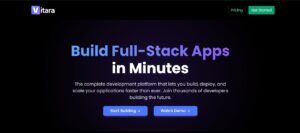
Vitara is a next-generation, AI-powered software development platform built for speed, scalability, and modern development workflows. It allows developers to go from concept to deployment without the traditional complexity of configuring environments or managing local tools. Everything happens in your browser—just describe what you want to build, and Vitara’s AI does the rest.
This tool is designed with a strong focus on full-stack development. It provides a smart IDE, clean code output, and real-time error handling—all in a secure and collaborative workspace. Whether you’re building an internal dashboard, a client-facing SaaS product, or a full-blown web app, Vitara helps you launch faster with full code ownership and production-ready output.
Key Features:
- AI-Driven App Generation
Use natural language prompts to describe your application, and Vitara instantly generates working components, layouts, and logic. - Production-Ready Code Output
Unlike many no-code tools, Vitara provides clean, editable code. You can export and host it anywhere, or continue working in the platform’s browser-based IDE. - Modern Tech Stack
Built on a solid foundation of ReactJS for the frontend and Supabase for backend services, Vitara supports real-time features, user authentication, and scalable databases. - Smart Error Detection
Vitara’s AI doesn’t just generate code—it also spots issues as you go. Built-in debugging tools make it easier to maintain clean and reliable apps. - Performance & Security Recommendations
The platform offers optimization tips, helping you fine-tune your app for speed, responsiveness, and secure practices before launch.
Pros:
- Enables incredibly fast full-stack development
- Offers total control with downloadable, production-quality code
- Zero setup—build right in your browser
- Built-in AI optimization guidance
- Secure and scalable with Supabase integration
Cons:
- May take some time to get used to AI workflows for traditional developers
- Currently optimized mainly for Supabase, which may not suit every backend use case
Pricing:
- Starter Plan: Free — Includes 5 messages/day and 25 messages/month for AI assistance
- Build Plan: $20/month — Adds 100 messages/month, private project support, and faster processing
- Elevate Plan: $50/month — Designed for power users, with 250 messages/month and advanced project features
Best For:
Vitara is perfect for solo developers, startup teams, and tech-savvy builders who want to cut through setup hassles and move from idea to launch in record time. If you’re seeking full-stack flexibility, real code output, and an AI assistant that actually understands dev logic, Vitara is a strong choice.
4.Softgen

Softgen is an AI-powered web app builder that empowers non-technical users to build polished, functional web applications—without ever writing code. Designed for speed and simplicity, Softgen uses AI to translate natural language prompts into real, working interfaces and logic. You describe what you want, and the platform does the rest.
It’s particularly useful for entrepreneurs, product designers, and teams that need to move fast without relying on full-time developers. From dashboards and forms to full-scale SaaS apps, Softgen helps you build tools that look great and work well—while saving time and budget.
Whether you’re testing a product idea or building a client solution, Softgen removes the traditional bottlenecks of software development through a blend of automation, design intelligence, and no-code workflows.
Key Features:
- AI-Powered Prompt Builder
Turn simple instructions into screens, workflows, and backend logic with the help of a smart assistant trained on modern UI/UX patterns. - No-Code Interface
Drag, drop, and customize components with ease. You can modify layouts, add forms, and connect data—all without touching code. - Integrated Backend Support
Build apps that do more than look good. Softgen offers built-in connections to databases, authentication, and third-party APIs. - Responsive Design Templates
Use flexible templates that adapt to mobile and desktop devices. Just pick a layout and customize it to fit your needs. - Built-in Hosting & Deployment
Once your app is ready, publish it directly from the platform—no need for third-party hosting services.
Pros:
- Extremely fast app creation using AI
- Great for users without any technical background
- Templates and UI elements are clean and professional
- Includes hosting, saving time and setup effort
Cons:
- Limited design flexibility for experienced designers
- May lack deeper customization options for complex workflows
- Dependency on the platform’s AI accuracy for best results
Pricing:
- Free Plan: Includes limited access to templates and AI prompts, ideal for quick testing
- Pro Plan: Pricing starts at $25/month; unlocks more features, app exports, and premium templates
- Custom Plans: Available for teams or agencies with larger project scopes
Best For:
Softgen is best suited for founders, marketers, and business teams that need to spin up apps quickly. It’s a great choice if you want professional output with zero code and minimal setup. For MVPs, client tools, or internal apps, Softgen delivers both speed and simplicity.
5. Uizard

Uizard is a no-code design and prototyping tool powered by AI, built to help users create app and website interfaces faster than ever. It’s specifically tailored for non-designers, startups, and product teams who want to turn ideas into polished prototypes—without needing professional design or coding skills.
What sets Uizard apart is its ability to transform hand-drawn sketches or plain text prompts into real, editable UI mockups in seconds. It feels more like working with a design assistant than a traditional software tool. Whether you’re building an app concept, a SaaS dashboard, or a mobile UI, Uizard simplifies the entire process—from wireframe to high-fidelity prototype.
Key Features:
- AI-Powered Design Assistant
Generate full layouts and screen flows from simple sketches or text prompts. Uizard interprets your ideas and builds on them visually. - Drag-and-Drop Interface Builder
Move components around, adjust layouts, and edit screens without needing any technical experience. - Theme and Style Generator
Upload brand assets or describe a look, and Uizard auto-generates design styles to match. Maintain a consistent visual identity across your project. - Real-Time Collaboration
Share your workspace with teammates, gather feedback, and co-edit designs just like Google Docs. - Template Library
Choose from a wide variety of pre-built templates for websites, mobile apps, and web dashboards to speed up the design process.
Pros:
- Extremely beginner-friendly with a minimal learning curve
- Converts rough ideas into refined UI mockups quickly
- Great for early-stage design validation and pitching
- No coding or design background required
- Real-time collaboration boosts team efficiency
Cons:
- Focuses mostly on design and prototyping—no full app deployment
- Limited backend integration or logic building for app functionality
- Advanced designers may find it too simplified
Pricing:
- Free Plan: Includes basic features, limited templates, and watermark on exports
- Pro Plan: $19/month — Unlocks advanced features, full template access, brand customization, and export options
- Team & Business Plans: Custom pricing available for large teams or enterprises
Best For:
Uizard is ideal for founders, product managers, marketers, and UX newcomers who need to design app or website prototypes without technical barriers. If you want to move from concept to clickable prototype in under an hour, Uizard delivers speed and simplicity—without sacrificing style.
6. Buildglare

Buildglare is an emerging AI-powered web app builder focused on making full-stack development accessible to creators, developers, and entrepreneurs with minimal setup or coding. It merges visual design, smart automation, and backend integration into one seamless browser-based experience.
Designed for speed and flexibility, Buildglare allows users to create apps with intelligent AI prompts, a drag-and-drop UI editor, and full code access when needed. Whether you’re building a startup MVP, client portal, or internal tool, Buildglare helps you ship faster—without sacrificing customization.
The platform is especially useful for those who want a little more control than traditional no-code tools but still appreciate the simplicity of a guided development process.
Key Features:
- AI-Powered App Building
Use simple prompts to describe what you want to build—Buildglare handles the layout, UI components, and logic setup. - Drag-and-Drop UI Editor
Quickly structure your frontend with reusable components, clean layouts, and responsive elements. - Backend Integration & Data Handling
Connect to external APIs, manage databases, and add dynamic functionality to your applications—all through a visual interface. - In-Browser IDE
For those who want to go deeper, Buildglare provides a live coding environment with support for editing and deploying custom logic. - One-Click Deployment
Push your app live without leaving the platform. Hosting is included, and apps are optimized for performance right out of the box.
Pros:
- Balanced blend of no-code simplicity and low-code flexibility
- Ideal for quick MVPs or production-ready tools
- Built-in hosting saves setup time
- Supports external integrations and custom workflows
- Clean UI and beginner-friendly documentation
Cons:
- Still growing—fewer advanced features than larger platforms
- UI design options may feel limited for designers seeking pixel-perfect control
- Occasional learning curve when switching between no-code and code views
Pricing:
- Free Plan: Includes basic AI prompts, limited deployments, and core components
- Basic Plan: $9.9/month — Adds API integration, backend logic, and more templates
- Pro Plan: $19.9/month — For teams or complex projects requiring scaling and collaboration
Best For:
Buildglare is a smart pick for solo founders, lean product teams, and developers who want a quick launch path with optional coding flexibility. If you’re looking for a platform that sits perfectly between no-code ease and developer-level customization, Buildglare fits the bill.
7. Bubble
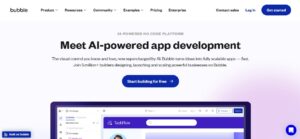
Bubble is one of the most popular and mature no-code platforms on the market, designed to help users build powerful web applications without writing code. It’s known for its deep customization options, visual programming interface, and robust plugin ecosystem, making it a top choice for startups, solo founders, and growing businesses.
Bubble stands out because it combines the flexibility of traditional coding with the accessibility of drag-and-drop tools. You can create complex workflows, connect APIs, and manage your database—all in a visual interface. It’s powerful enough to build SaaS platforms, marketplaces, and internal tools that scale.
Whether you’re creating your first MVP or a feature-rich business application, Bubble offers the flexibility to build and grow without switching tools.
Key Features:
- Visual Programming Interface
Design and develop apps using drag-and-drop components paired with logic-based workflows—no code required. - Built-in Database
Manage structured data directly inside Bubble, complete with privacy rules, user roles, and dynamic content rendering. - API Integration
Easily connect external tools and services through API connectors, enabling full-stack functionality. - Extensive Plugin Marketplace
Extend your app’s capabilities with thousands of third-party plugins, from payment processors to analytics tools. - Hosting & Scaling Built-In
Bubble takes care of hosting and performance scaling, so you can focus on building rather than server maintenance.
Pros:
- Deep customization with no-code logic and workflows
- Supports highly complex applications and use cases
- Integrated hosting, database, and deployment tools
- Strong community with tons of tutorials, plugins, and templates
- Great for long-term scalability
Cons:
- Steeper learning curve compared to simpler no-code tools
- UI builder can feel clunky for pixel-perfect design
- Performance may require optimization as apps grow
Pricing:
- Free Plan: Includes core features, community support, and test environment
- Starter Plan: $29/month — For live apps with branding, database storage, and basic capacity
- Growth Plan: $119/month — Includes performance boosts, backend triggers, and premium support
- Custom Plans: Available for large-scale apps and enterprise needs
Best For:
Bubble is ideal for founders, startups, and small teams who need to build complex web applications without hiring a full development team. If you want no-code power with near-code-level control over logic and design, Bubble offers one of the best all-in-one platforms out there.
8. Codev
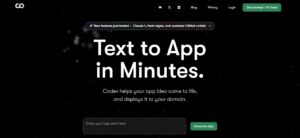
Codev is a versatile AI-powered development platform designed to turn simple ideas into full-stack applications quickly. It merges the best of low-code and AI generation, giving developers and non-tech users the ability to create custom applications through natural language prompts and a smart visual editor.
Unlike purely no-code platforms, Codev offers more technical depth. Users can fine-tune generated components, modify backend logic, and even dive into the code if needed. It’s a great bridge between ease-of-use and development flexibility—ideal for teams that want to go beyond templates but still avoid coding from scratch.
Whether you’re building a workflow tool, a customer portal, or a backend service with dashboards, Codev keeps the process smooth, fast, and efficient.
Key Features:
- AI Code Generation
Enter a simple description of your app, and Codev generates the frontend layout, data logic, and backend workflows with clean, editable code. - Drag-and-Drop UI Builder
Customize your interface visually using a modern, component-based editor that supports responsive layouts and pre-built modules. - Full Stack Support
Build both frontend and backend functionality in one place. Codev supports logic creation, data storage, API calls, and third-party integrations. - Editable Code View
Developers can view and edit the generated code for full control, making it ideal for custom functions and advanced configurations. - Built-In Deployment
Push your app live directly from the platform with hosting options included—no extra steps required.
Pros:
- Combines AI ease with technical depth
- Editable code for full customization
- Supports complex workflows and integrations
- Great for teams needing scalable, maintainable apps
- Hosting and backend included
Cons:
- May require some technical understanding for advanced features
- Still maturing—smaller plugin ecosystem than more established tools
- Interface occasionally less intuitive than mainstream no-code builders
Pricing:
- Free Tier: Includes basic app generation and limited usage of AI features
- Plus Plan: Starts at $19/month — Unlocks more storage, collaboration tools, and API usage
- Enterprise Plans: Available for teams with custom needs and support options
Best For:
Codev is best suited for developers, tech-savvy entrepreneurs, and teams who want to build smarter—not harder. It’s ideal if you’re looking for a balance between automated development and manual control, with the option to scale as your project grows.
9. Replit
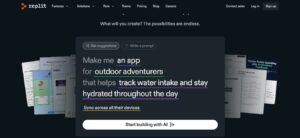
Replit is a powerful, browser-based coding environment that combines real-time collaboration, AI-assisted development, and full-stack deployment in a single platform. While it’s traditionally used by developers to code in multiple languages online, Replit has rapidly evolved into a robust AI-powered platform capable of building and launching full applications—without any local setup.
At its core, Replit is a developer-friendly IDE that runs entirely in the cloud. With built-in support for dozens of languages, integrated hosting, and its powerful Ghostwriter AI assistant, it’s become a go-to tool for developers, educators, and tech teams who want to code, collaborate, and ship—fast.
Whether you’re prototyping a new project, learning to code, or building production-ready tools, Replit makes the development cycle more accessible and lightning fast.
Key Features:
- Ghostwriter AI Assistant
Replit’s integrated AI helps you write, debug, and improve code in real time. Just describe what you need, and Ghostwriter offers intelligent suggestions. - In-Browser IDE
Code from anywhere, in any language, without installing anything. Replit supports Python, JavaScript, HTML/CSS, and many more languages out of the box. - Instant Deployment
With one click, deploy your app or website directly from your workspace. No external hosting configuration needed. - Multiplayer Mode
Collaborate with teammates in real time—just like Google Docs, but for code. See each other’s edits live. - Templates and Learning Tools
Use starter templates or follow coding tutorials built into the platform. Great for both beginners and experienced devs.
Pros:
- Extremely fast setup—start coding in seconds
- Supports dozens of programming languages
- Great for pair programming and remote team collaboration
- Integrated AI speeds up development
- Excellent for teaching, learning, and prototyping
Cons:
- Not a traditional no-code tool—requires basic coding knowledge
- Limited design-focused features (UI building not visual)
- Complex backend projects may need additional services outside Replit
Pricing:
- Free Plan: Includes basic features, limited storage, and Ghostwriter preview
- Hacker Plan: $7/month — Adds private Repls, more compute power, and faster Ghostwriter
- Pro & Teams Plans: Available for advanced dev needs with increased resources and collaboration features
Best For:
Replit is ideal for developers, coding learners, and technical teams who want a full-featured, AI-assisted development environment in the cloud. It’s not a no-code builder—but if you’re comfortable with coding and want to streamline the process from writing code to deployment, Replit is one of the fastest ways to build and ship applications online.
10. Hostinger Horizons
Hostinger Horizons is a rising no-code website builder that’s part of Hostinger’s broader hosting ecosystem. Tailored especially for small businesses and solopreneurs, Horizons emphasizes speed, affordability, and simplicity. It’s built for users who want to get online fast, without compromising on style or performance.
Key Features
- Drag-and-drop builder with responsive templates
- AI-powered content generator and layout suggestions
- Built-in SEO and marketing tools
- Seamless integration with Hostinger domains and hosting
- Lightweight, fast-loading pages
Pros
- Extremely beginner-friendly with a minimal learning curve
- Competitive pricing, especially for those already using Hostinger
- AI tools save time during site creation
- Designs optimized for mobile out-of-the-box
Cons
- Limited flexibility for advanced customizations
- Not ideal for large-scale or feature-heavy web apps
- Third-party plugin support is currently limited
Best For
Hostinger Horizons works best for small businesses, freelancers, and creators who want a fast and efficient website builder. It’s ideal for portfolio sites, landing pages, and local businesses that need an affordable, polished web presence without technical hassle.
Pricing
- Starts at a very low monthly rate when bundled with hosting
- Custom domain and business email are often included in premium plans
- Free plan not available, but a trial version can be accessed
Why It’s a Lovable Alternative
If Lovable.dev feels too developer-focused or overly complex, Hostinger Horizons offers a refreshing alternative. It strips away the noise, letting users focus on launching their brand quickly. With its AI features and built-in hosting, it’s a solid one-stop shop for non-technical users.
11. Noloco
Noloco is a powerful no-code platform that lets you build internal tools, client portals, and custom apps without writing a single line of code. It focuses on turning spreadsheets and Airtable bases into polished, data-driven applications. With its user-friendly UI and flexible access controls, Noloco is a favorite among startups, agencies, and operations teams that need fast, scalable tools.
Key Features
- Seamless integration with Airtable, Google Sheets, Postgres, and REST APIs
- Dynamic data-driven pages and forms
- Built-in user roles and permissions for secure access
- Branding customization and white-label options
- Workflow automation with conditional logic
Pros
- Great for transforming databases into professional apps
- Advanced user permission settings for multi-role use
- Fast deployment and live preview options
- Excellent community and support resources
Cons
- May feel complex for total beginners
- Less visual freedom than design-centric platforms
- Pricing can rise quickly as your app grows
Best For
Noloco is a great fit for teams that manage large datasets or need internal tools fast. It’s especially useful for agencies, client service businesses, and ops teams that rely on Airtable or Google Sheets and want a more interactive front-end.
Pricing
- Offers a 7-day free trial
- Paid plans start affordably, with limits based on users and data rows
- White-label and enterprise features available on higher tiers
Why It’s a Lovable Alternative
While Lovable.dev focuses on AI-driven app generation, Noloco gives you control over your data and user experience. It’s better suited for real-time dashboards, portals, and database-connected tools. If you’re looking for flexibility, team collaboration, and a strong data foundation Noloco delivers.
Other Notable Lovable Alternatives
While the top platforms cover a wide range of use cases, there are several other tools that offer innovative features and unique workflows worth exploring. These options may not fit every project, but they excel in specific areas like design automation, workflow logic, or AI-enhanced development.
Here’s a look at some standout alternatives that bring something different to the table:
Figma To Fullstack AI : Perfect for designers who want to go from mockups to code with minimal effort. This tool transforms Figma files into deployable, full-stack applications—saving developers hours of manual work.
Lazy AI: A lightweight but powerful builder that allows users to describe software functionality in plain English. From dashboards to forms, Lazy AI turns your ideas into real apps using natural language prompts.
GitLoop : Focused on developer collaboration, GitLoop uses AI to help write, review, and refactor code. Ideal for teams that want smarter version control and faster code feedback loops.
Builder.ai: A polished, no-code app builder guided by an AI assistant. Builder.ai asks questions about your app and builds it for you—ideal for business users with little to no tech background.
Kissflow : A workflow automation tool enhanced by AI. It’s great for automating repetitive business processes and optimizing internal operations through drag-and-drop logic and smart triggers.
Quickbase : This business app builder offers deep customization and flexible data structures. It’s often used for internal apps, dashboards, and workflow tools that need powerful data handling.
GitLab (with AI) : A full DevOps platform with added AI features for automation, code suggestions, and pipeline optimization. GitLab helps teams manage the entire software lifecycle efficiently.
ChatGPT : Not a builder in the traditional sense, but a powerhouse for ideation, content generation, code snippets, and problem-solving. Great for brainstorming features, fixing bugs, or writing documentation.
Tempo Labs : A developer-focused design system platform that bridges the gap between design and development. Ideal for teams building scalable design systems or handing off UI work.
Jitter : A motion design and animation tool built for UI/UX designers. Use it to add slick animations and interactive transitions to your web or app designs—fast and without code.
Deco.cx: A headless website builder with strong collaborative tools. It’s optimized for teams managing dynamic content and modern frontend stacks in a visual environment.
Quick Comparison of the 10+ Top Lovable Alternatives
| Platform | AI Capabilities | Customization & Control | Ease of Use | Target Users | Pricing Range |
|---|---|---|---|---|---|
| Bolt.new | Natural-language code generation | Real-time code & full-stack support | Medium–high learning curve | Devs, early-stage teams | Free → ~$20/month |
| Rosebud AI | Prompt-to-game-app AI | Low backend flexibility | Very high usability, playful | Creators, educators | Free → quote‑based |
| Vitara | AI-driven app scaffolding | Clean code, browser IDE | Moderate (for devs) | Solo devs, startups | Free → ~$50/month |
| Softgen | Natural-language no-code builder | Limited for complex workflows | Very easy for non-devs | Marketers, founders | Free → ~$25/month |
| Uizard | Sketch/text-to-UI tool | Design-focused only | Extremely user-friendly | Designers, PMs | Free → $19/month |
| Buildglare | AI-assisted full-stack creation | Backend logic, live code editor | Moderate; visual + code | Indie devs, startups | Free → ~$20/month |
| Bubble | Workflow AI templates | Deep customization, plugins | Steeper learning curve | SMBs, scalable projects | Free → ~$119+/month |
| Codev | Prompt + editable code output | Full-stack with manual overrides | Medium; some dev skill needed | Tech-savvy teams | Free → ~$19/month |
| Replit | Ghostwriter AI code assistant | Code-first, many languages | High for coders; not no-code | Developers, educators | Free → $7+/month |
| Hostinger Horizons | AI layout & content suggestions | Template-based, limited customization | Very easy for beginners | Small businesses, freelancers | Starts low with hosting bundle |
| Noloco | Minimal AI, strong data tools | Excellent for data-driven apps | Moderate; best for spreadsheet users | Agencies, ops teams, internal tools | Free trial → paid plans scale by users |
How to Choose the Right Lovable Alternative for Your Needs
Not every tool is built for every builder. Choosing the right Lovable alternative depends on your skills, goals, budget, and workflow preferences. Here’s a step-by-step guide to help you make the right pick.
1. Assess Your Technical Skills
Your technical background plays a big role in tool selection. If you’re a non-technical user, look for tools that offer visual building experiences with minimal setup. Platforms like Bubble, Builder.ai, and Rosebud AI are built for ease of use. They use drag-and-drop interfaces and prompt-based creation to help you launch apps without writing code.
If you’re a developer or technically inclined, you’ll likely want more control. In that case, go for platforms like Bolt.new, Softgen, or Replit. These tools offer deeper customization, real code access, and the ability to build complex applications from scratch—with or without AI assistance.
2. Define Your Project Goals
Knowing what you want to build will narrow your choices fast. For simple projects like landing pages, mockups, or MVPs, speed and simplicity matter most. Tools like Uizard and Tempo Labs help you get there quickly, with built-in templates and visual workflows.
If you’re building something more robust—like a full-stack web app, SaaS product, or internal tool—you’ll need more firepower. Platforms like Bubble, Replit offer backend logic, data integration, and scalable deployment options. These are built to support apps that grow with your business.
3. Consider Your Budget
Budget is often the biggest constraint, especially for early-stage builders. If you’re bootstrapping or just experimenting, consider free or low-cost tools like Lazy AI, Buildglare, and ChatLabs. They provide essential features with little or no upfront cost.
However, if you’re working with a team or planning to scale, it’s worth investing in more advanced plans. Tools like Bubble Growth Plan, Softgen Pro, or Backendless Pro offer better performance, collaboration tools, and support—making them ideal for scaling operations or launching paid products.
4. Identify Must-Have Features
What features can’t you live without? If backend logic is a priority, platforms like Replit and Bolt.new offer the control and flexibility you need. For beautiful UI design, tools like Jitter, Uizard, and Rosebud AI stand out for visual quality and user-friendliness.
Need robust third-party integrations? Platforms like Tempo Labs and GitLoop let you plug into APIs, databases, and other services—perfect for apps that rely on connected systems and automation.
5. Try Free Trials or Demos
Before making a final decision, test the waters. Most platforms offer free tiers, trials, or demo environments. Use these to explore the interface, understand the AI capabilities, and see how fast you can move from idea to output.
Pay attention to the UI, response times, deployment ease, and support availability. A few hours of testing can save you weeks of frustration—and help you find a platform that feels like the right fit for your workflow and goals.
Final Thoughts & Recommendations
Choosing the right Lovable alternative depends on who you are and what you’re building. If you’re a non-technical founder or designer, tools like Uizard, Bubble, or Builder.ai make it easy to get started without code. For developers or more technical users, platforms like Replit, Bolt.new offer greater flexibility and deeper control over backend logic and deployment.
For those focused on design, animation, or rapid prototyping, tools like Jitter, Rosebud AI, and Tempo Labs bring speed and creativity into the workflow. Meanwhile, platforms like Softgen, Buildglare, or Vitara offer strong middle-ground solutions for building real apps without a full dev team.
No matter your skill level, don’t rush into one tool. Test at least two or three platforms before settling long-term. Most offer free trials—use them to explore features, build a simple project, and see what fits your workflow.
FAQs Regarding Lovable alternatives
What is Lovable AI?
Lovable AI is a modern platform that helps developers build applications faster using artificial intelligence. It focuses on automating parts of the development process to save time and reduce manual effort.
This tool is especially useful for startups, solo developers, and teams looking to move quickly. Its goal is to make building software feel less like a chore and more like a creative process.
What are the best alternatives to Lovable.dev?
The top alternatives to Lovable.dev include Bolt.new, Rosebud AI, Vitara, Softgen, and Uizard. These AI-powered development tools offer features like browser-based coding, natural language–driven app generation, full-stack support, and visual UI/UX prototyping—helping you build smarter, faster, and with less code.
Why should I consider Lovable alternatives?
Lovable.dev is a great starting point for building AI-assisted applications, especially for non-technical users. It’s simple, fast, and designed for quick prototypes. However, as your project grows, you may find limitations in customization, backend control, or scalability.
That’s where alternatives come in.
Different platforms offer more advanced features, flexible tech stacks, or greater control over your code. Some are better for design. Others excel in backend development or full-stack support. Exploring alternatives helps you find a tool that fits your goals, team, and technical skills—whether you’re launching a simple app or a complex product.
How do the top Lovable alternatives differ from Lovable?
Most top Lovable alternatives go beyond just speed and simplicity. Vibe coding tools like Bubble, Replit offer deeper backend logic, scalable infrastructure, and real code export—features that Lovable doesn’t fully support.
Others, like Uizard or Rosebud AI, specialize in visual design or rapid prototyping, providing creative flexibility that’s ideal for early-stage concepts.
The biggest difference lies in control. With many alternatives, you can tweak the code, integrate third-party tools, or build more advanced workflows. These platforms often support real-time collaboration, API integration, and complex user logic—making them better suited for scaling products and teams.
Which Lovable alternative offers the most customization and control for experienced developers?
If you’re an experienced developer, tools like Replit, Bolt.new give you the most control. They let you edit real code, connect to custom APIs, and manage backend logic in detail.
These platforms don’t just generate code—they allow you to own it, refine it, and build on it. You can start with AI assistance but still go deep under the hood when needed. This makes them ideal for building scalable, secure, and feature-rich applications from the ground up.
How can I choose the best Lovable alternative for my business?
Start by understanding your needs. What are you building—a landing page, a full-stack app, or an internal tool? Define your project scope, timeline, and the features you can’t compromise on.
Next, consider your team’s technical skills. If you’re non-technical, look for drag-and-drop builders like Bubble or Builder.ai. For more control and customization, tools like Bolt.new or Replit are better suited.
Budget matters too. Explore platforms with free trials or affordable starter plans to test functionality without risk.
Finally, take each platform for a test drive. Build a small version of your app. See how intuitive the interface feels, how responsive support is, and whether the platform aligns with your long-term goals.
Choosing the right tool is about fit—not features alone. Pick what works best for your business flow and growth stage.
Avantika Shergil is a technology enthusiast and thought leader with deep expertise in software development and web technologies. With over 8 years of experience analyzing and evaluating cutting-edge digital solutions, Avantika has a knack for demystifying complex tech trends. Her insights into modern programming frameworks, system architecture, and web innovation have empowered businesses to make informed decisions in the ever-evolving tech landscape. Avantika is passionate about bridging the gap between technology and business strategy, helping businesses build customized software and website, and understand about different tools to leverage effectively for their ventures. Explore her work for a unique perspective on the future of digital innovation.



